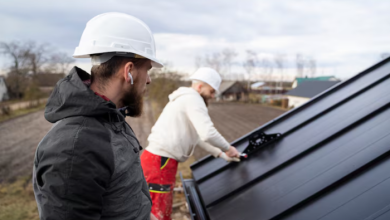
What Constitutes a Bomb Cyclone?
A bomb cyclone is a weather event that catches many off guard. It’s a storm system where the central pressure drops incredibly fast, at least 24 millibars in 24 hours. This rapid intensification is called ‘bombogenesis.’ Think of it like throwing fuel on a fire; the storm just explodes in strength. This sudden surge in power means winds pick up speed and rain or snow can become intense very quickly. Seattle residents know that storms can hit hard, but a bomb cyclone takes it to another level. When conditions escalate this quickly, storm damage Seattle services like those offered by Paul Davis Restoration become essential, as they specialize in responding fast to wind, flooding, and structural issues caused by severe weather events.
These powerful storms often form when cold, dry air from the Arctic meets warm, moist air from the Pacific Ocean. This clash creates instability, and the storm feeds off the moisture. The rapid pressure drop acts like a vacuum, pulling air in and making the winds howl. It’s this rapid development that makes a bomb cyclone so dangerous, often leaving little time to prepare for the severe weather conditions it brings.
The speed at which a bomb cyclone forms is its most defining and dangerous characteristic. This rapid intensification means that a storm can go from moderate to severe in a matter of hours. The Pacific Northwest, with its proximity to the ocean and its varied climate, is particularly susceptible to these intense weather systems. Understanding what makes a bomb cyclone tick is the first step in preparing for the damage it can inflict.
The Pacific Northwest’s Vulnerability
The Pacific Northwest, including Seattle, is no stranger to intense weather. Its location makes it a prime spot for storms to develop and intensify. The collision of moist Pacific air with colder continental air masses creates the perfect conditions for these powerful systems to form. This vulnerability means that Seattle residents need to be particularly aware of the potential for severe weather events like bomb cyclones.
Last year, the region experienced one of the most intense bomb cyclones on record. This event brought hurricane-force winds, heavy rain, and significant snowfall, causing widespread damage. Trees fell, power lines were downed, and hundreds of thousands of homes lost electricity. The sheer speed and force of the storm left communities struggling to recover for weeks.
This vulnerability isn’t just about one-off events. The frequency and intensity of these storms seem to be increasing. Scientists point to warmer ocean waters providing more energy for storms to rapidly intensify. This means that the threat of a bomb cyclone impacting Seattle is becoming more common, making preparedness a year-round concern.
Increasing Storm Frequency and Intensity
Data suggests that bomb cyclones are becoming more frequent and more powerful. This trend is a growing concern for regions like Seattle. Warmer ocean temperatures are providing more fuel for these storms, allowing them to intensify at an alarming rate through bombogenesis. This means that what might have been considered a rare event is becoming more common.
These intensified storms bring a host of damaging elements. We’re talking about wind gusts that can reach speeds of 70 to 80 mph, strong enough to topple trees and rip apart roofs. They also carry massive amounts of moisture, leading to torrential rainfall that can cause flash floods and mudslides. At higher elevations, this translates to heavy snow, making travel treacherous.
The combination of rapid intensification and the sheer volume of moisture these storms carry makes them particularly destructive. Seattle’s unique geography means it’s often in the direct path of these powerful weather systems. Being aware of this increasing trend is key to staying safe and protecting property from the damage a bomb cyclone can cause.
Wind Damage From Intense Storms
Hurricane-Force Wind Gusts
Seattle residents know that storms can pack a punch, but the intensity of wind damage from powerful systems can be surprising. When a storm rapidly intensifies, often referred to as a bomb cyclone, it can bring winds that rival those of a hurricane. These aren’t just strong breezes; we’re talking about gusts that can reach speeds of 70 to 80 mph or even higher. Such extreme wind speeds pose a significant threat to property and safety. This level of wind can cause widespread disruption across the region.
Impact on Trees and Power Lines
One of the most visible signs of intense wind damage is the effect on trees and the power lines they often share space with. High winds can snap large branches or even uproot entire trees, sending them crashing down onto homes, cars, and roads. This not only causes property damage but also creates dangerous debris. When trees fall on power lines, it leads to widespread power outages, leaving communities in the dark and disrupting daily life. The sheer force of the wind can also directly damage power lines, causing them to break or sag, further contributing to the outages.
Roof and Structural Damage
Beyond trees and power lines, the structural integrity of homes and buildings is also at risk during severe wind events. Intense winds can lift and tear away shingles, damage gutters, and even rip off entire sections of roofing. In the most extreme cases, walls can be compromised, and windows can shatter. This type of damage can lead to significant water intrusion if not addressed quickly, causing further problems like mold and rot. It’s a stark reminder of how vulnerable even sturdy structures can be to the raw power of nature. Preparing for these storms means considering how to protect your home’s exterior from these damaging winds.
Flooding and Water Damage Risks

Torrential Rain and Flash Flooding
Seattle residents know that heavy rain can be a problem, but intense storm systems can bring truly torrential downpours. When rain falls too fast for drains to keep up, flash flooding can happen quickly. This isn’t just about inconvenience; it’s about potential danger to homes and property. Water can rise rapidly, overwhelming basements and ground floors.
The sheer volume of water from these storms can overwhelm local drainage systems. This leads to water backing up into streets and yards. Areas that don’t typically flood can become hazardous. It’s important to stay informed about weather alerts and avoid driving through flooded areas. The risk of flooding is a serious concern for many Seattle neighborhoods.
Mudslides and Debris Flows
Steep hillsides are common in the Seattle area, and heavy rainfall can destabilize them. This creates a risk of mudslides and debris flows. Loose soil, rocks, and vegetation can be swept downhill with incredible force. These events can be sudden and destructive, posing a significant threat to homes located below or near vulnerable slopes. Keeping an eye on the weather and understanding your property’s location relative to hillsides is key.
When the ground becomes saturated from prolonged or intense rain, it loses its stability. This is especially true on slopes that have been disturbed by construction or lack adequate vegetation cover. The resulting mudslide can carry large objects, causing severe damage.
Coastal and Inland Water Intrusion
Storms don’t just bring rain from the sky; they can also push water inland. High winds associated with intense storms can drive ocean water into coastal areas, causing flooding. Even for homes further inland, storm surges and overwhelmed rivers can lead to water intrusion. This type of flooding can be particularly damaging as it often carries salt water or polluted river water, increasing the potential for structural damage and mold growth. Preparing for water damage means considering all sources of water, not just rainfall.
Snowfall and Winter Weather Hazards
Heavy Snow Accumulation
Seattle’s proximity to mountainous regions means that heavy snow can sometimes impact the city, especially during intense winter storms. When significant snowfall occurs, it can quickly overwhelm local infrastructure. Roads can become impassable, making travel difficult and dangerous. This type of weather event can lead to widespread disruptions, affecting daily commutes and emergency service access.
Accumulations of over six inches can significantly impact transportation. This is particularly true for areas with less frequent snow, where residents and city services may not be fully equipped to handle such volumes. The weight of heavy snow can also pose a risk to structures, especially older roofs not designed for substantial snow loads. Preparing for heavy snow means having a plan for clearing driveways and walkways, and ensuring your home is ready for the added weight.
Blizzard-Like Conditions
While not as common as in other parts of the country, Seattle can experience conditions that mimic blizzards, especially when combined with strong winds. These events bring reduced visibility due to blowing snow and extremely cold temperatures. Such conditions can create hazardous travel situations, making it unsafe to be outdoors. The combination of wind and snow can lead to drifting snow, further complicating efforts to clear roads and access services.
These blizzard-like conditions can isolate neighborhoods and strain resources. Power outages are also more likely during these intense winter weather events. It’s important for residents to stay informed about weather alerts and to have emergency supplies on hand. Being prepared can make a significant difference when facing severe winter weather.
Impact on Transportation and Infrastructure
Winter weather, including heavy snowfall and icy conditions, poses a significant threat to Seattle’s transportation network. Roads can become slick and dangerous, leading to increased accidents and traffic delays. Public transportation services may be reduced or suspended altogether, impacting many residents’ ability to get to work or access essential services. The city’s infrastructure, including power lines and water systems, can also be affected by freezing temperatures and heavy snow.
The rapid intensification of winter storms, sometimes referred to as bomb cyclones, can bring sudden and severe weather changes, catching many off guard. This fast development means less time to prepare for the impacts on transportation and infrastructure.
Here’s what to watch for:
- Icy Roads: Freezing rain or melting snow refreezing overnight creates treacherous driving conditions.
- Power Outages: Heavy snow and ice can weigh down power lines, causing them to snap.
- Transit Delays: Snowfall can disrupt bus routes and light rail services, leading to significant delays or cancellations.
- Bridge and Overpass Freezing: These elevated structures freeze faster than regular roads, requiring extra caution.
Electrical and Power System Disruptions
Widespread Power Outages
Intense storms, especially those classified as bomb cyclones, can bring about widespread power outages. These events often feature high winds that can snap power lines and topple utility poles. The sheer force of these storms means that damage isn’t isolated; it can affect entire neighborhoods or even larger regions. When these systems hit, residents should be prepared for extended periods without electricity. This disruption impacts daily life, from heating and cooling to communication and refrigeration.
Damage to Electrical Infrastructure
The electrical infrastructure is particularly vulnerable during severe weather. Falling trees and branches are a common culprit, directly impacting power lines and substations. Heavy snow accumulation can weigh down lines, causing them to sag or break. Furthermore, flooding can inundate underground electrical equipment, leading to short circuits and system failures. Repairing this damage often requires specialized crews and can be a complex and time-consuming process, especially when access is limited by storm conditions. The goal is always to restore power safely and efficiently.
Restoration Challenges
Restoring power after a major storm presents significant challenges. Crews must first assess the full extent of the damage, which can be difficult in hazardous conditions. Accessing damaged areas might be hindered by debris, flooding, or impassable roads. Prioritizing repairs to critical facilities like hospitals and emergency services is paramount. The process of repairing electrical infrastructure is methodical, involving replacing damaged poles, lines, and transformers. The safety of repair crews is always the top priority, and they often work long hours in difficult circumstances to bring power back to affected communities. Dealing with widespread power outages requires patience and understanding from residents.
Preparing Your Seattle Home for Storms
Securing Outdoor Items
When intense storms hit Seattle, loose outdoor items can become dangerous projectiles. Take a few minutes to secure patio furniture, garbage cans, and any other objects that could be blown around. A strong gust of wind can turn a lightweight chair into a serious hazard. This simple step helps prevent damage to your property and your neighbors’.
Tree Maintenance Near Your Property
Seattle’s beautiful trees are a part of its charm, but they can pose a significant risk during severe weather. Regularly inspect trees on your property for dead or weak branches. Consider hiring a professional arborist to trim back limbs that hang over your house or power lines. This proactive approach to tree maintenance can prevent costly damage from falling branches during a storm.
Emergency Supply Kits
Having a well-stocked emergency supply kit is vital for any Seattle resident facing storm threats. Aim to have enough non-perishable food, water, and essential medications for at least three days. Don’t forget flashlights, extra batteries, a first-aid kit, and a battery-powered or hand-crank radio to stay informed. Preparing your home and family with these supplies can make a big difference when the next storm hits.
Staying Prepared for Seattle’s Storms
Seattle’s weather can certainly pack a punch, and understanding the types of storm damage that can happen is the first step toward staying safe. From wind that can topple trees and power lines to heavy rains that might cause flooding, these events are a reality for the region. Keeping an eye on the forecast and taking simple steps like securing outdoor items and having emergency supplies ready can make a big difference when severe weather hits. Being prepared means less worry and a quicker recovery if the worst does occur.




